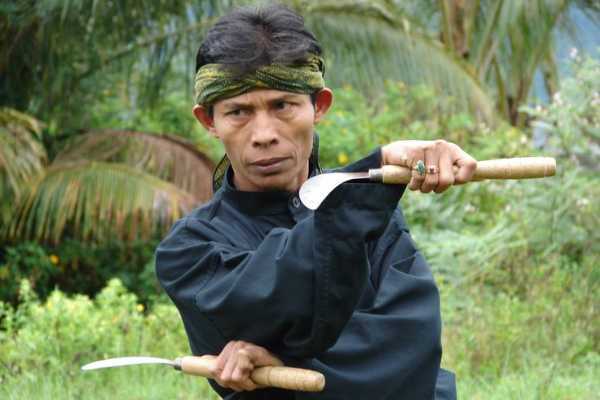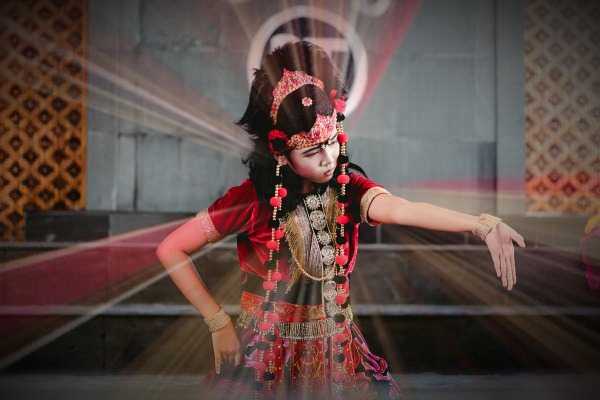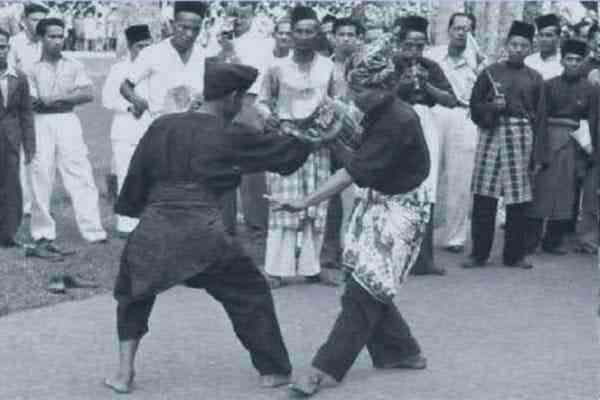The dance of silat dirty boxing martial arts is an efficient mnemonic learning system. This tradition is an effective way to conceal martial arts tactics so they can be practiced without drawing attention.
Silat is a prime example of martial arts hiding in plain sight. The Gamelan is a traditional Indonesian orchestra with instruments like gongs and drums. When people practiced silat, they did it to the rhythm of the Gamelan music. In this way, they looked like they were just dancing.
How to Conceal Martial Arts Tactics
It is easy to identify punching and kicking as fighting tactics. The stances and standardized movements of karate are also well known. However, the cultural dances of Silat are filled with strange slapping, twists, and turns. To the untrained eye, they don’t look like a martial art.
Silat emerged alongside ancient martial arts systems, borrowing the best from both worlds. Many Silat systems are much older than the systems developed in Japan and Korea. They are largely unknown because they conceal martial arts tactics from commercialization.
Indonesia has been occupied by foreign powers, from the Dutch to the Japanese. The occupiers did not want the Indonesians to have fighting skills because they feared they might use them to resist or fight back. The Indonesians could keep their martial arts alive by hiding their training within the dance. This way, they preserved their fighting skills and cultural heritage, even during difficult times.
Silat is not just about fighting but also about self-discipline, respect, and community. The practice of these arts helped people stay connected to their roots and maintain a sense of identity. The Gamelan music added cultural richness. It makes the training a celebration of Indonesian heritage.
Today, silat is recognized worldwide for its beauty and effectiveness. It symbolizes resilience and ingenuity, showing how a community can adapt and thrive even under oppression. By preserving silat through the silat dance, they ensured their art would survive. This clever strategy protected their fighting skills and kept their culture vibrant and alive.
Moreover, these martial arts tactics have other practical benefits. They teach self-defense, improve physical fitness, and enhance mental focus. The movements are graceful yet powerful, combining agility with strength. Practitioners learn to be aware of their surroundings and to react quickly to any threat.
Practicing Martial Arts Hiding in Plain Sight
How do you practice your fighting skills in a society forbidding such activities? The best way to conceal martial arts tactics is to make their practice part of the cultural dance tradition. Tell your oppressors it’s just an artistic dance form. Then, your oppressors will provide an outlet for the practice of the art.
Many ancient traditions use movement or dance and drumming as communication devices. Some cultures invested considerable time learning how to use movement and sound. Indonesian martial arts systems use these tools as mnemonic learning devices. (1) It makes the silat dance or the dance of silat efficient.
Silat is the ideal method for achieving the full power of an effective martial art. It combines internalized music, practical applications, and ocular and breath control. It produces a state where you can train the body and mind practicing martial arts hiding in plain sight.
What can you learn by using this strategy? It helps us understand how to use the parasympathetic nervous system to control how we respond to threats.
The Dance of Silat Dirty Boxing Martial Arts
Silat is often called “dirty boxing” because it uses techniques considered unsafe. All martial arts combat sports have rules of engagement. Boxing, karate, and mixed martial arts (MMA) have strict rules and regulations to ensure safety. On the other hand, silat embraces a no-holds-barred approach to fighting. Practitioners who conceal martial arts tactics are often underestimated.
In silat, practitioners use whatever means to defend themselves and defeat opponents. These tactics include techniques like groin strikes, eye gouges, headbutts, and joint manipulations. These are all the methods prohibited by combat sports. These methods defeat an opponent quickly but can cause serious injury and even death. It makes silat highly effective in real-world self-defense situations. The emphasis is on survival and practicality rather than adhering to a set of rules.
The term “dirty boxing” highlights its practical nature. It is a martial art that evolved in Indonesia’s streets and villages. Its main goal was to protect oneself and one’s community from threats. This practical approach means anything goes in a fight. Practitioners are trained to exploit any vulnerability they can find.
Silat’s reputation as “dirty boxing” also stems from its adaptability. Practitioners learn to use their environment to their advantage. They might pick up a stick, use a cloth to entangle an opponent, or use deceptive movements to catch an adversary off guard. This versatility makes silat a formidable martial art capable of adapting to any situation.
In summary, silat is known as “dirty boxing, ” it prioritizes survival over rules. Its techniques are practical and efficient. They often target vulnerable areas of the body that are off-limits in other martial arts. This approach makes silat a powerful and respected form of self-defense.
Controlling the Nervous System
Controlling the nervous system is a key aspect of silat, the Indonesian martial art. The use of peripheral vision is key to overriding the sympathetic nervous system. (2) This system is responsible for the fight, flight, or freeze response, the 3F response. This is an automatic survival response which is triggered in stressful, dangerous situations. The body releases adrenaline and prepares for immediate action.
The primitive sympathetic nervous system can help in emergencies. But it shuts down the brain’s higher centers. This limits clear thinking and strategic decision-making.
The other characteristic of the primitive mind is that it links to our emotions of fear and anger. In combat, these emotions impede making the best decisions. It requires moving in the right way at the right time. This kind of precision requires the higher-thinking center of the parasympathetic nervous system. It makes the dance of silat effective. It becomes martial arts hiding in plain sight.
Speed is bull____. Timing is everything. ― Guru Tua
Face-to-face confrontations can trigger the emotions of fear and anger. So, we must learn techniques that help us maintain emotional equilibrium. We know SN wants to trigger our fight, flight, or freeze reaction, so we train to prevent this. (3)
Thus, the biggest battle is always with the Self. You’ll need to learn how to manage these emotions. This is essential to combat and also works in other areas of life.

The Three Keys to The Silat Dance
How do you enable the parasympathetic nervous system to stay online in a life-threatening situations? Trying to ignore or control your fear and anger often doesn’t work. So, you need a method that prevents the sympathetic nervous system (SN) from engaging. Here’s how this control and training are achieved:
1. Peripheral Vision and Eye Control
Peripheral vision is crucial for controlling involuntary reactions of the 3F response. It keeps the mind focused and free from emotions like fear or anger. The eyes are often called the windows to the soul and play a vital role in controlling the nervous system. If you watch a seasoned silat practitioner, you’ll notice their unblinking stare. This isn’t just for show; it’s an essential aspect of the system.
2. Controlled Breathing
Breath control is a valuable asset during a confrontation. If you can’t breathe, you can’t fight. Some teachers use breathing techniques that make the diaphragm flutter. Others prefer slow, steady breathing. Some practitioners use specific sounds or words. They correspond with the slapping techniques in Jurus. These methods help maintain calm and focus.
3. Gamelan Music Integration
Listening to gamelan music encodes martial arts movements into the practitioner’s muscle memory. Practitioners train to recall the music while performing the silat dance in combat. This enables a seamless integration of martial applications into their dance.
When these elements are combined, they ensure fluid thinking and movement. This approach allows you to apply dance as a martial art. It eliminates the interference of powerful emotions like fear and anger. It produces a mindset which provides a distinct advantage in a combative confrontation. In this sense, a physical fight transforms into a dance. The silat dance enables the practice of martial arts to hide in plain sight.
Silat Training Examples
One training scenario involves water. It is thrown in the face as the practitioner engages in the dance and then an opponent. Maintaining peripheral vision through these exercises helps control the 3F response.
Students learn to verbalize the techniques as they do them. So, when you practice a standard method to twist the head and break your opponent’s neck, you say, “Piting Kapala!” which translates to “twisting head.” Language adds another layer to the encoding of the technique.
The first step to learning Lankas and Jurus is to perform them in a flowing silat dance. Use different variations and call out the method as you go. When you learn a traditional Silat form, you automatically learn the Mayla language.
The Dragon dance is where practitioners form a line and begin their dance following the leader. They weave in and out, mimicking the leader’s techniques. They then engage another line of practitioners. This training trains practitioners to work as a team and protect other members.
Observing The Dance of Silat Dirty Boxing Martial Arts
It doesn’t look like other commercial martial arts with consistent “starts and stops.” It does not follow a constant pace or flow of movement, which is intentional. Many movements are jerky and contain changes in direction. They also include circular, straight-line actions with unusual cadence and tempos.

The one constant of the experienced practitioner is an unblinking stare. You hear them practice their art, slapping their arms, body, and legs using guttural sounds. Many say the movement while executing the Juru. These are all part of the techniques within the dance. They practice and “fight” with their dance. This is how they conceal martial arts tactics effectively.
Combat is not the only goal of the dance. This tradition also incorporates natural healing techniques. Pejut is a healing art and is the predecessor of Reiki and Shiatsu. Pejut contains the energy gained from practicing the dance. It is a healing art like Reiki but has massage elements like Shiatsu.
Learning the Silat Dance
Silat comes in many forms, each with its unique flavor depending on the region and the teacher’s background. The body type of students also plays a role in how they are trained. The teacher’s experience is crucial in choosing the right way to train each student.
Many teachers practice multiple silat styles. They develop a unique approach, often using ideas from Chinese martial arts. These teachers are very protective of their methods and for good reasons. They don’t want to teach a bully to be better at bullying.
An excellent teacher will have a vetting process to determine if someone is ready to learn these powerful techniques. A poor student can cause harm to themselves and their teacher. As Guru Tua wisely said:
Never teach a monkey to use a hand-grenade. You never know what they will do with it. ― Guru Tua
This quote emphasizes the importance of the careful selection of students. It highlights the need for wisdom and discernment in passing on the art of silat.
Summary
The dance of Silat, dirty boxing, and martial arts serves as a mnemonic memory device for the ultimate combat training system. It is a perfect way to conceal martial arts tactics and training. The cultural aspect of the dance enables the practice of martial arts, hiding in plain sight. This strategy has helped preserve the art for hundreds of years.
Silat, dirty boxing, and martial arts can generate energy. This energy can be channeled into the healing arts, a key part of the tradition. You will help heal those you train with and vice versa. This practice requires you to feed your soul and build your spirit. Seasoned teachers help students see the need to address any emotional or personality issues first. Having a solid base of grounding and centering gained through meditation is also beneficial.
References
(1) Memory and Mnemonic Devices. Psychcentral.com
(2) Neuroanatomy, Sympathetic Nervous System. National Institute of Health
(3) Physiological Responses During Matches and Profile of Elite Pencak Silat Exponents. National Institute of Health
